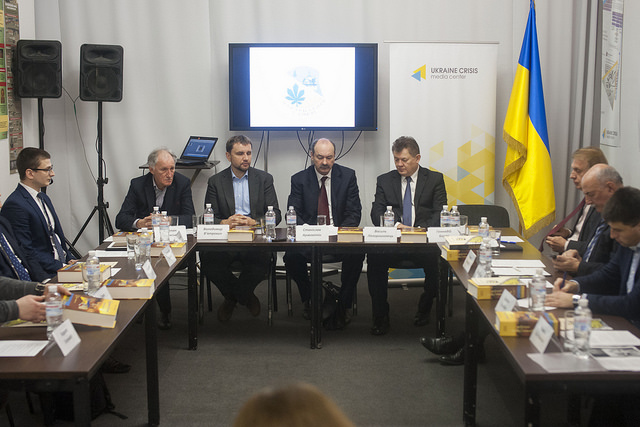The proclamation of independence of Carpathian Ukraine on March 15, 1939 in Khust can be considered the first step toward full independence of Ukraine. This conclusion was reached at the public discussion devoted to the 78th anniversary of the events held at Ukraine Crisis Media Center. “Carpathian Ukraine did not exist long, just one day, but even then, Transcarpathian people showed their desire for reunification with Ukraine,” stressed Vasyl Lazoryshynets, director of the Amosov National Institute of Cardiovascular Surgery, president of the Transcarpathian Brotherhood in Kyiv.
Volodymyr Viatrovych, head of the Ukrainian Institute of National Memory, noted that now there is an attempt to launch public rethinking of World War II. “The events in 1939 demonstrated one of the important trends, which was typical for Ukrainians throughout World War II – a desire to become a subject, their longing for independence and striving to unite and live in one state,” he said.
Carpathian Ukraine was a presidential republic with the state language – Ukrainian. The official flag was blue and yellow, the Ukrainian national anthem – “Ukraine is still alive”. The President of Carpathian Ukraine was Augustyn Voloshyn.
On the night of March 13 to 14, 1939 the Hungarian army began military operations near Mukachevo. A small Carpathian Sich army resisted a large and powerful regular army of the invaders. Bohdan Halaiko, director of the National Research Institute of Ukrainian Studies, drew attention to the executions of Sich soldiers who were prisoners of war, and added that currently there are fewer and fewer living witnesses of those events who can testify to it. According to various sources, about 300 students were killed then. 230 Carpathian Sich fighters were killed on the first day of armed oppositions.
Oleksandr Pahiria, historian, researcher of topic, said: “The government of Czechoslovakia was on a short leash of Berlin.” He added that the proclaimed state had not been recognized by any state in the world, despite Voloshyn’s active negotiations. Pavlo Hay-Nyzhnyk, head of historical studies department of the National Research Institute of Ukrainian Studies, stressed that Poland openly said that Carpathian Ukraine must be destroyed, because it would lead to the independence of the whole Ukraine. “This example, when we were actually double-crossed, proves that you cannot pay off the aggressor,” he concluded. These events had no international consequences for the region – it was a local conflict in “Silver land”. In late March, Transcarpathia was finally occupied by Hungarian troops.
“The Carpathian Ukraine is an example of brilliant self-organization of people and their awareness of individual responsibility for their future at the crucial moment,” emphasized Orest Klympush, MP of Ukraine of 2nd and 4th convocations, 1st grade Envoy Extraordinary and Plenipotentiary of Ukraine, son of Dmytro Klympush, chief commandant of the people’s defense “Carpathian Sich” in 1938-1939. Oleksandr Rubliov, scientist, secretary of the Institute of History of Ukraine of the National Academy of Sciences of Ukraine, noted that the Second World War for Ukraine started with aggression in the Transcarpathian Ukraine, and added: “Despite its short duration, this event is of political and geopolitical importance.”
Stepan Vidniansky, head of international relations and foreign policy department of the Institute of History of Ukraine of the National Academy of Sciences of Ukraine, called the events a brand new stage in the struggle for the state formation. He reviewed the events that preceded the declaration of independence by a separate part of Ukraine. The indigenous people – the Rusyns – were separated from the center of the state and followed their own way. Kyrylo Halushko, historian, public educational coordinator of the project “Likbez. Historic Front,” added “Not all regions got to choose their Ukrainian identity, which was officially declared.” This is a transformation of regional consciousness into national. The fact that at different times in the 20th century these areas were under nine states and state entities also played an important part. Under those circumstances the Carpathian Ukraine was unable to be autonomous and sovereign.
Volodymyr Ohryzko, diplomat, Ambassador Extraordinary and Plenipotentiary of Ukraine, Minister of Foreign Affairs of Ukraine (2007-2009), said that the greatpowerness disease does not originate from the European continent. And attempts to revive it would mean the blood. “The rhetoric that bears the aggression and attempts to interfere with the internal affairs of the states, pose threats, and we should resist them,” warned Mr. Ohryzko.

